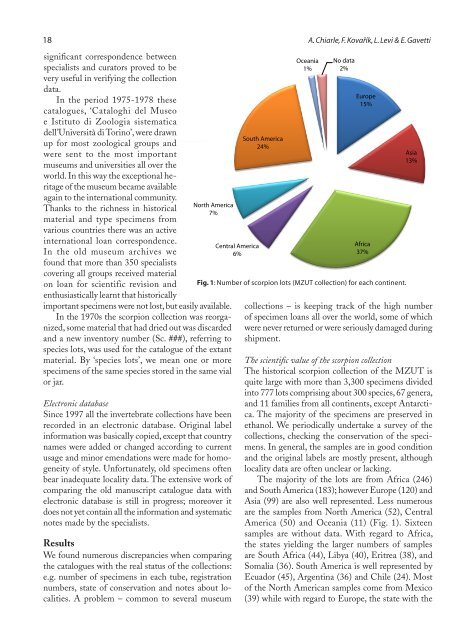Chiarle A, Kovařík F, Levi L & Gavetti E - European Society of ...
Chiarle A, Kovařík F, Levi L & Gavetti E - European Society of ...
Chiarle A, Kovařík F, Levi L & Gavetti E - European Society of ...
Create successful ePaper yourself
Turn your PDF publications into a flip-book with our unique Google optimized e-Paper software.
18 A. <strong>Chiarle</strong>, F. <strong>Kovařík</strong>, L. <strong>Levi</strong> & E. <strong>Gavetti</strong><br />
significant correspondence between<br />
specialists and curators proved to be<br />
very useful in verifying the collection<br />
data.<br />
In the period 1975-1978 these<br />
catalogues, ‘Cataloghi del Museo<br />
e Istituto di Zoologia sistematica<br />
dell’Università di Torino’, were drawn<br />
up for most zoological groups and<br />
were sent to the most important<br />
museums and universities all over the<br />
world. In this way the exceptional heritage<br />
<strong>of</strong> the museum became available<br />
again to the international community.<br />
Thanks to the richness in historical<br />
material and type specimens from<br />
various countries there was an active<br />
international loan correspondence.<br />
In the old museum archives we<br />
found that more than 350 specialists<br />
covering all groups received material<br />
on loan for scientific revision and<br />
enthusiastically learnt that historically<br />
North America<br />
7%<br />
important specimens were not lost, but easily available.<br />
In the 1970s the scorpion collection was reorganized,<br />
some material that had dried out was discarded<br />
and a new inventory number (Sc. ###), referring to<br />
species lots, was used for the catalogue <strong>of</strong> the extant<br />
material. By ‘species lots’, we mean one or more<br />
specimens <strong>of</strong> the same species stored in the same vial<br />
or jar.<br />
Electronic database<br />
Since 1997 all the invertebrate collections have been<br />
recorded in an electronic database. Original label<br />
information was basically copied, except that country<br />
names were added or changed according to current<br />
usage and minor emendations were made for homogeneity<br />
<strong>of</strong> style. Unfortunately, old specimens <strong>of</strong>ten<br />
bear inadequate locality data. The extensive work <strong>of</strong><br />
comparing the old manuscript catalogue data with<br />
electronic database is still in progress; moreover it<br />
does not yet contain all the information and systematic<br />
notes made by the specialists.<br />
Results<br />
We found numerous discrepancies when comparing<br />
the catalogues with the real status <strong>of</strong> the collections:<br />
e.g. number <strong>of</strong> specimens in each tube, registration<br />
numbers, state <strong>of</strong> conservation and notes about localities.<br />
A problem – common to several museum<br />
Central America<br />
6%<br />
South America<br />
24%<br />
Oceania<br />
1%<br />
No data<br />
2%<br />
Europe<br />
15%<br />
Africa<br />
37%<br />
Fig. 1: Number <strong>of</strong> scorpion lots (MZUT collection) for each continent.<br />
Asia<br />
13%<br />
collections – is keeping track <strong>of</strong> the high number<br />
<strong>of</strong> specimen loans all over the world, some <strong>of</strong> which<br />
were never returned or were seriously damaged during<br />
shipment.<br />
The scientific value <strong>of</strong> the scorpion collection<br />
The historical scorpion collection <strong>of</strong> the MZUT is<br />
quite large with more than 3,300 specimens divided<br />
into 777 lots comprising about 300 species, 67 genera,<br />
and 11 families from all continents, except Antarctica.<br />
The majority <strong>of</strong> the specimens are preserved in<br />
ethanol. We periodically undertake a survey <strong>of</strong> the<br />
collections, checking the conservation <strong>of</strong> the specimens.<br />
In general, the samples are in good condition<br />
and the original labels are mostly present, although<br />
locality data are <strong>of</strong>ten unclear or lacking.<br />
The majority <strong>of</strong> the lots are from Africa (246)<br />
and South America (183); however Europe (120) and<br />
Asia (99) are also well represented. Less numerous<br />
are the samples from North America (52), Central<br />
America (50) and Oceania (11) (Fig. 1). Sixteen<br />
samples are without data. With regard to Africa,<br />
the states yielding the larger numbers <strong>of</strong> samples<br />
are South Africa (44), Libya (40), Eritrea (38), and<br />
Somalia (36). South America is well represented by<br />
Ecuador (45), Argentina (36) and Chile (24). Most<br />
<strong>of</strong> the North American samples come from Mexico<br />
(39) while with regard to Europe, the state with the
















